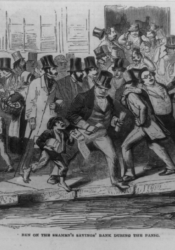1857 Financial Crisis
In 1857, Britain and the United States shared a financial crisis that began in the US and spread overseas, and which is “generally regarded as the first world-wide Financial Crisis” (Shakinovsky).
During the first 7 years of the 1850s, Britain was experiencing a period of extreme profitability and affluence. Their export market had expanded by 66% as innovations in the form of trains, steamships, and telegraphs alongside colonial expansion drove the economy to new heights.
In the United States, the crisis began on 24 August, 1857, with the fall of the Ohio State Life and Trust Company, and at its peak the panic resulted in the failure of 1,415 banks in the United States. England’s economy was heavily intermixed with the United States’, and while the spread of the panic was delayed, it did eventually prove contagious. Glasgow and Liverpool, the two cities most involved in American trade, were the first to feel the effects, with the first domino being the fall of the Liverpool Borough Bank on 27 October.
Basically, the banks had more loans, debts, and deposits than they had currency and bullion reserves, so when people lost trust in the banks and withdrew their money, the banks found their currency reserves depleting and had to close their doors.
To combat this panic, the British government suspended the Bank Charter Act of 1844, which had required banks to have bullion (gold and silver reserves) to back up all the currency in circulation. The idea of the act was that it would prevent risky speculation on the part of the banks and investors, but the booming markets and economy of the 1850s had encouraged risky ventures, which proved vulnerable as soon as the market contracted due to the panic. Suspending the act allowed for more paper currency to be issued, allowing the banks to have sufficient currency on hand. This suspension took some time to be effective, but it did eventually succeed in calming the panic and the crisis was declared officially over on December 24, 1857.
The crisis threw into stark relief the perils of the capitalist system and the growing pains of currency systems, and the issues with tying currency to physical bullion reserves amidst the growing British and world economies.
Source:
Shakinovsy, Lynn. “The 1857 Financial Crisis and the Suspension of the 1844 Bank Act.” BRANCH: Britain, Representation, and Nineteenth-Century History. Ed. Dino Franco Felluga. Extension of Romanticism and Victorianism on the Net. http://www.branchcollective.org/?ps_articles=lynn-shakinovsky-the-1857-financial-crisis-and-the-suspension-of-the-1844-bank-act. Accessed 2 November 2020.

